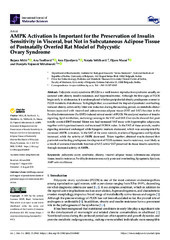Приказ основних података о документу
AMPK Activation Is Important for the Preservation of Insulin Sensitivity in Visceral, but Not in Subcutaneous Adipose Tissue of Postnatally Overfed Rat Model of Polycystic Ovary Syndrome
| dc.creator | Mićić, Bojana | |
| dc.creator | Teofilović, Ana | |
| dc.creator | Đorđević, Ana | |
| dc.creator | Veličković, Nataša | |
| dc.creator | Macut, Djuro | |
| dc.creator | Vojnović-Milutinović, Danijela | |
| dc.date.accessioned | 2022-08-31T11:06:48Z | |
| dc.date.available | 2022-08-31T11:06:48Z | |
| dc.date.issued | 2022 | |
| dc.identifier.issn | 1422-0067 | |
| dc.identifier.uri | http://radar.ibiss.bg.ac.rs/handle/123456789/5022 | |
| dc.description.abstract | Polycystic ovary syndrome (PCOS) is a well-known reproductive syndrome usually associated with obesity, insulin resistance, and hyperinsulinemia. Although the first signs of PCOS begin early in adolescence, it is underexplored whether peripubertal obesity predisposes women to PCOS metabolic disturbances. To highlight that, we examined the impact of postnatal overfeedinginduced obesity, achieved by litter size reduction during the suckling period, on metabolic disturbances associated with visceral and subcutaneous adipose tissue (VAT and SAT) function in the 5 -dihydrotestosterone (5 -DHT)-induced animal model of PCOS. We analyzed markers of insulin signaling, lipid metabolism, and energy sensing in the VAT and SAT. Our results showed that postnatally overfed DHT-treated Wistar rats had increased VAT mass with hypertrophic adipocytes, together with hyperinsulinemia and increased HOMA index. In the VAT of these animals, insulin signaling remained unchanged while lipogenic markers decreased, which was accompanied by increased AMPK activation. In the SAT of the same animals, markers of lipogenesis and lipolysis increased, while the activity of AMPK decreased. Taken together, obtained results showed that postnatal overfeeding predisposes development of PCOS systemic insulin resistance, most likely as a result of worsened metabolic function of SAT, while VAT preserved its tissue insulin sensitivity through increased activity of AMPK. | sr |
| dc.language.iso | en | sr |
| dc.publisher | Basel: MDPI | sr |
| dc.relation | info:eu-repo/grantAgreement/MESTD/inst-2020/200007/RS// | sr |
| dc.rights | openAccess | sr |
| dc.rights.uri | https://creativecommons.org/licenses/by/4.0/ | |
| dc.source | International Journal of Molecular Sciences | sr |
| dc.subject | polycystic ovary sindrome | sr |
| dc.subject | obesity | sr |
| dc.subject | visceral adipose tissue | sr |
| dc.subject | subcutaneous adipose tissue | sr |
| dc.subject | insulin resistance | sr |
| dc.subject | 5a-dihydrotestosterone | sr |
| dc.subject | early postnatal overfeeding; | sr |
| dc.subject | lipogenesis | sr |
| dc.subject | lipolysis | sr |
| dc.subject | AMP-activated kinase | sr |
| dc.title | AMPK Activation Is Important for the Preservation of Insulin Sensitivity in Visceral, but Not in Subcutaneous Adipose Tissue of Postnatally Overfed Rat Model of Polycystic Ovary Syndrome | sr |
| dc.type | article | sr |
| dc.rights.license | BY | sr |
| dc.rights.holder | © 2022 by the authors. Licensee MDPI, Basel, Switzerland | sr |
| dc.citation.issue | 16 | |
| dc.citation.volume | 23 | |
| dc.identifier.doi | 10.3390/ijms23168942 | |
| dc.identifier.pmid | 36012206 | |
| dc.identifier.scopus | 2-s2.0-85137671130 | |
| dc.identifier.wos | 00084583810000 | |
| dc.citation.apa | Mićić, B., Teofilović, A., Djordjevic, A., Veličković, N., Macut, D., & Vojnović Milutinović, D. (2022). AMPK Activation Is Important for the Preservation of Insulin Sensitivity in Visceral, but Not in Subcutaneous Adipose Tissue of Postnatally Overfed Rat Model of Polycystic Ovary Syndrome. International Journal of Molecular Sciences, 23(16), 8942. | |
| dc.citation.vancouver | Mićić B, Teofilović A, Djordjevic A, Veličković N, Macut D, Vojnović Milutinović D. AMPK Activation Is Important for the Preservation of Insulin Sensitivity in Visceral, but Not in Subcutaneous Adipose Tissue of Postnatally Overfed Rat Model of Polycystic Ovary Syndrome. Int J Mol Sci. 2022;23(16):8942. | |
| dc.citation.spage | 8942 | |
| dc.type.version | publishedVersion | sr |
| dc.identifier.fulltext | https://radar.ibiss.bg.ac.rs/bitstream/id/10781/bitstream_10781.pdf | |
| dc.citation.rank | M21 |

